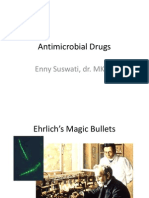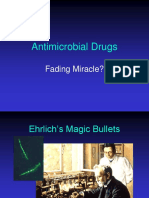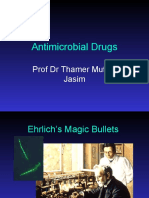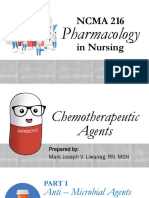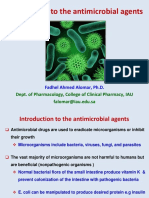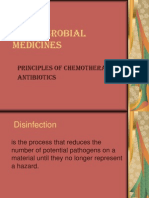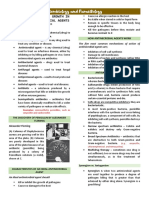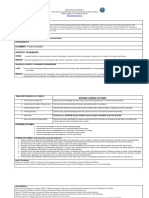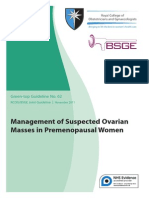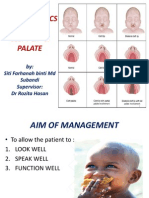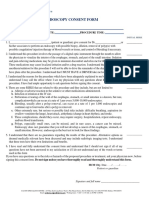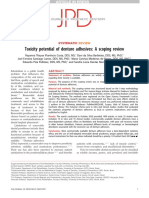Lecture 11 Chemotherapy and Antibiotics
Introduction
- antimicrobial drug: chemical substance that destroys disease-causing
microorganisms w/ minimal damage to host tissues
- chemotherapeutic agents: chemicals that combat disease in the body
- natural antibiotic: chemical produced by a microorganism that inhibits or kills
other microorganisms at low conc. -> most are not useful b/c of poor uptake or
toxicity
- semi-synthetic antibiotic: chemically modified natural antibiotics
- synthetic antibiotic: wholly synthesized in the lab
Natural and semisynthetic penicillin
- natural: produced by the mold Penicillium, effective against gram + cocci and
spirochetes
- semisynthetic: made in the lab by adding different R groups onto B-lactam ring
made by fungus
o resistant to penicillinases and have broader spectrum of activity than
natural
Spectrum of antimicrobial acitivity
- fungal infections are more difficult to treat b/c they have eukaryotic cells
- narrow-spectrum: affect only select grp of microbes (ex. gram +)
o ex. small hydrophilic drugs affect gram - broad-spectrum: affect large number (ex. both gram + and -)
Effect of combinations of drugs
- synergistic: more effective when taken together (1+1 =3)
- antagonistic: when taken together, both become less effective when taken alone
Mechanisms of action of antimicrobial drugs (either bactericidal kill v.
bacteriostatic inhibit growth)
Antibiotics: effective against bacteria, NOT against viruses
1. inhibition of cell wall synthesis: inhibit peptidoglycan synthesis
- ex. beta-lactams (penicillin), vancomycin, bacitracin
2. inhibition of protein synthesis: inhibit translation
- ex. chloramphenicol, macrolides, tetracyclines -> act on prokaryotic
ribosomes
3. inhibition of nucleic acid synthesis: inhibit DNA replication, mRNA transcription
(inhibit DNA gyrase)
- ex. quinolones, rifampin
4. damage to plasma membranes: alter cell membrane rigidity (ex. polymyxin B)
5. act as antimetabolites: inhibit enzyme activity or synthetic metabolic inhibitors
- ex. sulfonamides or growth factor analogs
Antivirals: target virus-specific enzymes and processes
- ex. nucleoside analogs and other drugs that inhibit nucleic acid polymerases and
viral genome replication
o host cells produce interferon proteins that stop viral replication
o nucleoside/nucleotide analogs inhibit DNA or RNA synthesis
o amantadine blocks penetration or uncoating of influenza A virus
o agents like protease inhibitors (PIs) interfere w/ HIV maturation steps
Antifungal drugs: b/c fungi are Eukarya, selective toxicity is hard to achieve
Antiprotozoan drugs: treat parasitic protozoan infections -> stop DNA synthesis by
intercalation b/w base pairs
Antihelminthic drugs: treat parasitic worms (Helminths)
�Lecture 11 Chemotherapy and Antibiotics
Effectiveness of Chemotherapeutic Agents
Tests to guide chemotherapy
- used for 1) to determine which agent is most likely to combat a specific
pathogen, 2) when susceptibility cannot be predicted, 3) when drug resistance
arises
- Disk-diffusion method: in Kirby-Bauer test, filter paper disks impregnated w/
antibiotic are overlaid on bacterial culture inoculated on agar medium
o Absence of microbial growth = zone of inhibition
o Diameter, when compared w/ standardized reference table, determines if
organism is sensitive, intermediate, or resistant to drug
- Broth dilution tests: microorganism is grown in liquid media containing diff. conc.
of agent
o Minimum inhibitory conc. (MIC): lowest conc. capable of preventing
microbial growth
o Minimum bactericidal conc. (MBC): lowest conc. that kills bacterial
Antimicrobial Drug Resistance
- 6 mechanisms of drug resistance
o prevention of penetration to target site = lack of entry
o rapid efflux (actively pumping the drug out of the cell) (greater exit)
o enzymatic inactivation of the drug
o alteration of drug target (drug cant bind target)
o development of resistant alternative metabolic pathway
- development of antimicrobial drug resistance
o resistance is accelerated by indiscriminate use of antimicrobial drugs
(overuse or misuse)
o results from selection of resistance genes, R-factors, that are
chromosomal or carried by plasmids and transposons
o some are multiple drug resistant (MDR)
o superinfections: when a pathogen develops resistance to the drug being
used or when normally resistant microbiota multiply excessively
Search for new antimicrobial drugs
- analogs of existing drugs are often developed to be used as next-gen
- computer drug design
- chemicals produced by plants and animals provide new agents, including
peptides
- new antimicrobials include DNA that is complementary to specific genes in a
pathogen -> the DNA will bind to pathogens DNA and inhibit protein synthesis




